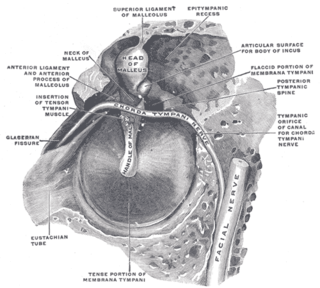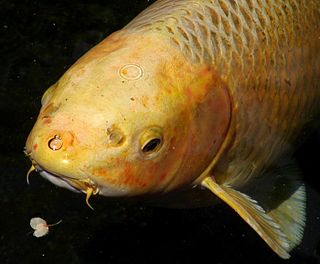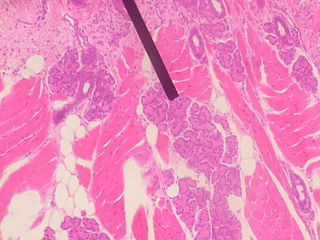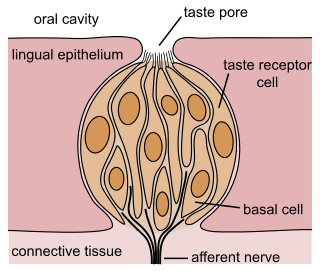Related Research Articles

The tongue is a muscular organ in the mouth of a typical tetrapod. It manipulates food for chewing and swallowing as part of the digestive process, and is the primary organ of taste. The tongue's upper surface (dorsum) is covered by taste buds housed in numerous lingual papillae. It is sensitive and kept moist by saliva and is richly supplied with nerves and blood vessels. The tongue also serves as a natural means of cleaning the teeth. A major function of the tongue is the enabling of speech in humans and vocalization in other animals.

Umami, or savoriness, is one of the five basic tastes. It has been described as savory and is characteristic of broths and cooked meats.
Dysgeusia, also known as parageusia, is a distortion of the sense of taste. Dysgeusia is also often associated with ageusia, which is the complete lack of taste, and hypogeusia, which is a decrease in taste sensitivity. An alteration in taste or smell may be a secondary process in various disease states, or it may be the primary symptom. The distortion in the sense of taste is the only symptom, and diagnosis is usually complicated since the sense of taste is tied together with other sensory systems. Common causes of dysgeusia include chemotherapy, asthma treatment with albuterol, and zinc deficiency. Liver disease, hypothyroidism, and rarely, certain types of seizures can also lead to dysgeusia. Different drugs can also be responsible for altering taste and resulting in dysgeusia. Due to the variety of causes of dysgeusia, there are many possible treatments that are effective in alleviating or terminating the symptoms. These include artificial saliva, pilocarpine, zinc supplementation, alterations in drug therapy, and alpha lipoic acid.

The salivary glands in many vertebrates including mammals are exocrine glands that produce saliva through a system of ducts. Humans have three paired major salivary glands, as well as hundreds of minor salivary glands. Salivary glands can be classified as serous, mucous, or seromucous (mixed).

Taste buds are clusters of taste receptor cells, which are also known as gustatory cells. The taste receptors are located around the small structures known as papillae found on the upper surface of the tongue, soft palate, upper esophagus, the cheek, and epiglottis. These structures are involved in detecting the five elements of taste perception: saltiness, sourness, bitterness, sweetness and savoriness (umami). A popular myth assigns these different tastes to different regions of the tongue; in fact, these tastes can be detected by any area of the tongue. Via small openings in the tongue epithelium, called taste pores, parts of the food dissolved in saliva come into contact with the taste receptors. These are located on top of the taste receptor cells that constitute the taste buds. The taste receptor cells send information detected by clusters of various receptors and ion channels to the gustatory areas of the brain via the seventh, ninth and tenth cranial nerves.

The paired submandibular glands are major salivary glands located beneath the floor of the mouth. In adult humans, they each weigh about 15 grams and contribute some 60–67% of unstimulated saliva secretion; on stimulation their contribution decreases in proportion as parotid gland secretion rises to 50%. The average length of the normal adult human submandibular salivary gland is approximately 27 mm, while the average width is approximately 14.3 mm.

Chorda tympani is a branch of the facial nerve that carries gustatory (taste) sensory innervation from the front of the tongue and parasympathetic (secretomotor) innervation to the submandibular and sublingual salivary glands.
Black hairy tongue syndrome (BHT) is a condition of the tongue in which the small bumps on the tongue elongate with black or brown discoloration, giving a black and hairy appearance. The appearance may be alarming, but it is a harmless condition. Predisposing factors include smoking, xerostomia, soft diet, poor oral hygiene and certain medications. Management is facilitated by improving oral hygiene, especially scraping or brushing the tongue.
The oral mucosa is the mucous membrane lining the inside of the mouth. It comprises stratified squamous epithelium, termed "oral epithelium", and an underlying connective tissue termed lamina propria. The oral cavity has sometimes been described as a mirror that reflects the health of the individual. Changes indicative of disease are seen as alterations in the oral mucosa lining the mouth, which can reveal systemic conditions, such as diabetes or vitamin deficiency, or the local effects of chronic tobacco or alcohol use. The oral mucosa tends to heal faster and with less scar formation compared to the skin. The underlying mechanism remains unknown, but research suggests that extracellular vesicles might be involved.
In medicine and anatomy, the special senses are the senses that have specialized organs devoted to them:

Geographic tongue, also known by several other terms, is a condition of the mucous membrane of the tongue, usually on the dorsal surface. It is a common condition, affecting approximately 2–3% of the general population. It is characterized by areas of smooth, red depapillation which migrate over time. The name comes from the map-like appearance of the tongue, with the patches resembling the islands of an archipelago. The cause is unknown, but the condition is entirely benign, and there is no curative treatment. Uncommonly, geographic tongue may cause a burning sensation on the tongue, for which various treatments have been described with little formal evidence of efficacy.
Burning mouth syndrome (BMS) is a burning, tingling or scalding sensation in the mouth, lasting for at least four to six months, with no underlying known dental or medical cause. No related signs of disease are found in the mouth. People with burning mouth syndrome may also have a subjective xerostomia, paraesthesia, or an altered sense of taste or smell.

In fish anatomy and turtle anatomy, a barbel is a slender, whiskerlike sensory organ near the mouth. Fish that have barbels include the catfish, the carp, the goatfish, the hagfish, the sturgeon, the zebrafish, the black dragonfish and some species of shark such as the sawshark. Barbels house the taste buds of such fish and are used to search for food in murky water.

Von Ebner's glands, also called Ebner's glands or gustatory glands, are exocrine glands found in the mouth. More specifically, they are serous salivary glands which reside adjacent to the moats surrounding the circumvallate and foliate papillae just anterior to the posterior third of the tongue, anterior to the terminal sulcus.

A taste receptor or tastant is a type of cellular receptor which facilitates the sensation of taste. When food or other substances enter the mouth, molecules interact with saliva and are bound to taste receptors in the oral cavity and other locations. Molecules which give a sensation of taste are considered "sapid".

Taste receptor type 1 member 3 is a protein that in humans is encoded by the TAS1R3 gene. The TAS1R3 gene encodes the human homolog of mouse Sac taste receptor, a major determinant of differences between sweet-sensitive and -insensitive mouse strains in their responsiveness to sucrose, saccharin, and other sweeteners.

The tongue map or taste map is a common misconception that different sections of the tongue are exclusively responsible for different basic tastes. It is illustrated with a schematic map of the tongue, with certain parts of the tongue labeled for each taste. Although widely taught in schools, this is incorrect; all taste sensations come from all regions of the tongue, although certain parts are more sensitive to certain tastes.

The gustatory system or sense of taste is the sensory system that is partially responsible for the perception of taste (flavor). Taste is the perception stimulated when a substance in the mouth reacts chemically with taste receptor cells located on taste buds in the oral cavity, mostly on the tongue. Taste, along with the sense of smell and trigeminal nerve stimulation, determines flavors of food and other substances. Humans have taste receptors on taste buds and other areas, including the upper surface of the tongue and the epiglottis. The gustatory cortex is responsible for the perception of taste.

Lingual papillae are small structures on the upper surface of the tongue that give it its characteristic rough texture. The four types of papillae on the human tongue have different structures and are accordingly classified as circumvallate, fungiform, filiform, and foliate. All except the filiform papillae are associated with taste buds.

The human digestive system consists of the gastrointestinal tract plus the accessory organs of digestion. Digestion involves the breakdown of food into smaller and smaller components, until they can be absorbed and assimilated into the body. The process of digestion has three stages: the cephalic phase, the gastric phase, and the intestinal phase.
References
- 1 2 B. G. Kapoor, H. E. Evans, E. A. Pevzner "The gustatory system in fish" in Advances in Marine Biology, Volume 13 (1976), F. S. Russell, Maurice Yonge (eds).
- ↑ Robert Bentley Todd, The Cyclopaedia of Anatomy and Physiology: Volume 1 (1836), p. 532.
